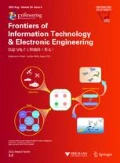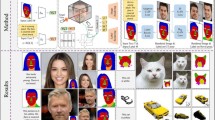Abstract
To promote the development of the intangible cultural heritage of the world, shadow play, many studies have focused on shadow puppet modeling and interaction. Most of the shadow puppet figures are still imaginary, spread by ancients, or carved and painted by shadow puppet artists, without consideration of real dimensions or the appearance of human bodies. This study proposes an algorithm to transform 3D human models to 2D puppet figures for shadow puppets, including automatic location of feature points, automatic segmentation of 3D models, automatic extraction of 2D contours, automatic clothes matching, and animation. Experiment proves that more realistic and attractive figures and animations of the shadow puppet can be generated in real time with this algorithm.
Similar content being viewed by others
References
Allen, B., Curless, B., Popovic, B., 2003. The space of human body shapes: reconstruction and parameterization from range scans. ACM Trans. Graph., 22(3):587–594. [doi:10.1145/882262.882311]
Chen, T.K., 2014. A case study of a digital archives programme: the development of digital shadow plays in Taiwan. Int. J. Human. Arts Comput., 8(suppl):38–48. [doi:10.3366/ijhac.2014.0098]
Currell, D., 2008. Shadow Puppets & Shadow Play. Crowood Press, UK.
Dekker, L., Khan, S., West, E., et al., 1998. Models for understanding the 3D human body form. Proc. Int. Conf. on Computer Vision, p.65–74.
Dekker, L., Douros, I., Buston, B.F., et al., 1999. Building symbolic information for 3D human body modeling from range data. Proc. 2nd Int. Conf. on 3-D Digital Imaging and Modeling, p.388–397. [doi:10.1109/IM.1999.805369]
Geisen, G.R., Mason, C.P., Houston, V.L., et al., 1995. Automatic detection, identification, and registration of anatomical landmarks. Proc. Human Factors and Ergonomics Society Annual Meeting, p.750–753. [doi:10.1177/154193129503901107]
Ghani, D.A., 2011a. A study of visualization elements of shadow play technique movement and computer graphic imagery (CGI) in Wayang Kulit Kelantan. Int. J. Comput. Graph. Animat., 1(1):1–11.
Ghani, D.A., 2011b. Wayang Kulit: digital puppetry character rigging using Maya MEL language. Proc. 4th Int. Conf. on Modeling, Simulation and Applied Optimization, p.1–5. [doi:10.1109/ICMSAO.2011.5775499]
Golovinskiy, A., Funkhouser, T., 2008. Randomized cuts for 3D mesh analysis. ACM Trans. Graph., 27(5), Article 145. [doi:10.1145/1409060.1409098]
Gutiérrez, M., García-Rojas, A., Thalmann, D., et al., 2007. An ontology of virtual humans. Vis. Comput., 23(3):207–218. [doi:10.1007/s00371-006-0093-4]
Held, R.T., Gupta, A., Curless, B., et al., 2012. 3D puppetry: a Kinect-based interface for 3D animation. UIST, p.423–434.
Jernigan, D.K., Chansavang, A., Martin-Rall, H., et al., 2013. Aesthetic affordances: computer animation andWayang Kulit puppet theatre. Animat. Pract. Process Product., 3(1–2):195–217. [doi:10.1386/ap3.3.1-2.195_1]
Kalogerakis, E., Hertzmann, A., Singh, K., 2010. Learning 3D mesh segmentation and labeling. ACM Trans. Graph., 29(4), Article 102. [doi:10.1145/1778765.1778839]
Katz, S., Tal, A., 2003. Hierarchical mesh decomposition using fuzzy clustering and cuts. ACM Trans. Graph., 22(3):954–961. [doi:10.1145/882262.882369]
Katz, S., Leifman, G., Tal, A., 2005. Mesh segmentation using feature point and core extraction. Vis. Comput., 21(8–10):649–658. [doi:10.1007/s00371-005-0344-9]
Kavan, L., Dobbyn, S., Collins, S., et al., 2008. Polypostors: 2D polygonal impostors for 3D crowds. Proc. Symp. on Interactive 3D Graphics and Games, p.149–155. [doi:10.1145/1342250.1342273]
Lam, T.K., Talib, A.Z., Osman, M.A., 2008. Real-time visual simulation and interactive animation of shadow play puppets using OpenGL. World Acad. Sci. Eng. Technol., 21:212–218.
Lewark, E.A., Nurre, J.H., 1998. Automated fudicial labeling on human body data. Proc. SPIE, p.82–89. [doi:10.1117/12.302440]
Li, Q., Hua, Q.Y., Feng, J., et al., 2011. Design and implementation of interactive digital shadow simulation system. Proc. Int. Conf. on Electric and Electronics, p.187–194. [doi:10.1007/978-3-642-21762-3_24]
Li, T.Y., Hsu, S.W., 2007. An authoring tool for generating shadow play animations with motion planning techniques. Int. J. Innov. Comput. Inform. Contr., 3(6B):1601–1612.
Liu, J.L., 1988. Chinese Shadow Puppet Plays. Morning Glory Publishers, China (in Chinese).
Matusky, P., 1994. Malaysian Shadow Play and Music: Continuity of an Oral Tradition. South-East Asian Social Science Monographs. Oxford University Press, Kuala Lumpur.
McHenry, K., Bajcsy, P., 2008. An Overview of 3D Data Content, File Formats and Viewers. Technical Report, National Center for Supercomputing Applications, Urbana, USA.
Morse, L., 2013. The shadow puppet theatre of Malaysia: a study of Wayang Kulit with performance scripts and puppet designs. Theat. J., 65(1):137–138.
Mortara, M., Patané, G., Spagnuolo, M., 2006. From geometric to semantic human body models. Comput. Graph., 30(2):185–196. [doi:10.1016/j.cag.2006.01.024]
Nurre, J.H., 1997. Locating landmarks on human body scan data. Proc. Int. Conf. on Recent Advances in 3-D Digital Imaging and Modeling, p.289–295. [doi:10.1109/IM.1997.603878]
Nurre, J.H., Connor, J., Lewark, E.A., et al., 2000. On segmenting the three-dimensional scan data of a human body. IEEE Trans. Med. Imag., 19(8):787–797. [doi:10.1109/42.876304]
Salij, H.J., 1982. Shadow Play and Other Stories. Heinemann Asia, Singapore.
Shapira, L., Shamir, A., Cohen-Or, D., 2008. Consistent mesh partitioning and skeletonisation using the shape diameter function. Vis. Comput., 24(4):249–259. [doi:10.1007/s00371-007-0197-5]
Simari, P., Nowrouzezahrai, D., Kalogerakis, E., et al., 2009. Multi-objective shape segmentation and labeling. Comput. Graph. Forum, 28(5):1415–1425. [doi:10.1111/j.1467-8659.2009.01518.x]
Skipitares, T., 2013. A new aesthetic in Indian puppetry. PAJ, 35(3):61–68. [doi:10.1162/PAJJ_a_00162]
Talib, A.Z., Osman, M.A., Tan, K.L., et al., 2012. Design and development of an interactive virtual shadow puppet play. Proc. 2nd Int. Conf. on Arts and Technology, p.118–126. [doi:10.1007/978-3-642-33329-3_14]
Tilley, A.R., 1993. The Measure of Man andWoman: Human Factors in Design. Whitney Library of Design, New York.
van Ness, E., Prawirohardjo, S., 1981. Javanese Wayang Kulit: an Introduction. Oxford University Press, USA.
Wang, C.C.L., Chang, T.K.K., Yuen, M.M.F., 2003. From laser-scanned data to feature human model: a system based on fuzzy logic concept. Comput.-Aid. Des., 35(3):241–253. [doi:10.1016/S0010-4485(01)00209-3]
Wang, I.C., 2013. Globalization and theater spectacles in Asia. CLCWeb: Compar. Liter. Cult., 15(2), Article 22. [doi:10.7771/1481-4374.2234]
Werghi, N., Xiao, Y.J., Siebert, J.P., 2006. A functionalbased segmentation of human body scans in arbitrary postures. IEEE Trans. Syst. Man Cybern. B, 36(1):153–165. [doi:10.1109/TSMCB.2005.854503]
Wuhrer, S., Ben Azouz, Z., Shu, C., 2010. Semi-automatic prediction of landmarks on human models in varying poses. Proc. Canadian Conf. on Computer and Robot Vision, p.136–142. [doi:10.1109/CRV.2010.25]
Zhang, H., Song, Y.H., Chen, Z., et al., 2012. Chinese shadow puppetry with an interactive interface using the Kinect sensor. Proc. Computer Vision, p.352–361. [doi:10.1007/978-3-642-33863-2_35]
Zhu, Y.B., Li, C.J., Shen, I.F., et al., 2003. A new form of traditional art: visual simulation of Chinese shadow play. Proc. ACM SIGGRAPH Sketches & Applications, p.1. [doi:10.1145/965400.965458]
Author information
Authors and Affiliations
Corresponding author
Additional information
Project partly supported by the National Natural Science Foundation of China (Nos. 61103100, 61303137, and 51205059), the Natural Science Foundation of Zhejiang Province, China (Nos. Y13F020143 and LY13F030002), and the Fundamental Research Funds for the Central Universities, China (No. 2014QNA5009)
ORCID: Xiao-fang HUANG, http://orcid.org/0000-0002-1210-7580
Rights and permissions
About this article
Cite this article
Huang, Xf., Sun, Sq., Zhang, Kj. et al. A method of shadow puppet figure modeling and animation. Frontiers Inf Technol Electronic Eng 16, 367–379 (2015). https://doi.org/10.1631/FITEE.1400351
Received:
Revised:
Published:
Issue Date:
DOI: https://doi.org/10.1631/FITEE.1400351




